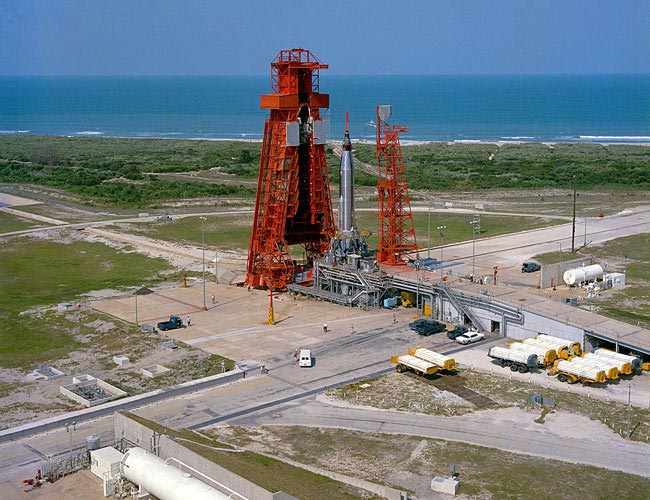Historic Mercury Launch Pad Reimagined As Classroom

Thelaunch pad used by the first United States astronauts to enter orbit around Earthmay soon be revived as an engineering classroom for a new generation of rocketbuilders, where laid off space shuttle technicians are the teachers.
JenniferScheer, who will soon end her eight-year career servicing NASA's orbiters,conceived the idea, which she has dubbed "ProjectMercury Rising." She has proposed restoring the Complex 14 launch pad CapeCanaveral Air Force Station in Florida to give students hands-on engineeringexperience working with a replica Mercury-Atlas rocket.
Thisspace camp for budding rocket builders would then trade the replicas for thereal thing, sending payloads the students build into space on commercialrockets launched from a nearby active pad.
"Thisidea [behind Project Mercury Rising] formulated as something that could bothrefurbish the launch complex and educate and inspire kids after the shuttleprogram is over," wrote Scheer in an e-mail to collectSPACE.com."It would also employ former shuttle program workers and help the areaeconomically."
AsScheer envisions, engineers and technicians who have or will soon lose theirjobs as a result of NASA's shuttle program shutting down next year would act asinstructors and mentors.
Therise and fall of Complex 14
Erectedin 1957 to support the development of the Atlas intercontinental ballisticmissile, Launch Complex 14 (LC-14) was the departure point for four Mercurymissions that launched the first U.S. astronauts into orbit, including JohnGlenn's history-making three orbits in February 1962. [Photos:Mercury astronaut John Glenn in orbit]
Get the Space.com Newsletter
Breaking space news, the latest updates on rocket launches, skywatching events and more!
Thesame pad later supported the unmanned Agena target vehicle launches duringNASA's follow-on two-man Gemini program before the pad was deactivated in 1967.
Inthe decades that have passed since it was abandoned as a launch pad, LC-14 hasevolved into part conference center, part monument, and part ruins.
In1976, the almost 150-foot (45.7 meters) mobile service structure that toweredover the pad's concrete ramp and launch stand was toppled and scrapped afterfalling victim to excessive rust.
Thenearby blockhouse with its 10.5-inch (26.6-cm) thick walls was renovated in1988 to host meetings for the Air Force. A monument installed on the ramp andanother outside the complex perimeter stand to remind visitors of the historicrole the pad once served.
Showingrather than telling
Scheerthinks that the pad should actively demonstrate its history, rather than havemarkers describe it.
"Idon't feel that the site is living up to its potential," she said."It gets occasional visits from tour groups, but from what I have beentold, the tour buses from the Kennedy Space Center Visitor Complex no longereven go to the site itself, they stop at the monument in front only."
"IfProject Mercury Rising was approved, it would breathe new life into the site.Students would go there to learn and become inspired. Aerospace experts wouldshare their knowledge with the next generation of space workers."
"Itruly care about making the site a fitting tribute to the astronauts wholaunched there and those on the ground who made it all possible," Scheer said.
Continuereading at collectSPACE.com ?about the balance between the pad?s historicalrestoration and making it safe for students.
- Gallery- Project Mercury: America's 1st Astronauts
- Top 10 Revelations ofthe Space Age
- SpaceShuttle Technician Turns Sunrise Tradition Into Book
Copyright2010 collectSPACE.com.All rights reserved.
Join our Space Forums to keep talking space on the latest missions, night sky and more! And if you have a news tip, correction or comment, let us know at: community@space.com.

Robert Pearlman is a space historian, journalist and the founder and editor of collectSPACE.com, a daily news publication and community devoted to space history with a particular focus on how and where space exploration intersects with pop culture. Pearlman is also a contributing writer for Space.com and co-author of "Space Stations: The Art, Science, and Reality of Working in Space” published by Smithsonian Books in 2018.In 2009, he was inducted into the U.S. Space Camp Hall of Fame in Huntsville, Alabama. In 2021, he was honored by the American Astronautical Society with the Ordway Award for Sustained Excellence in Spaceflight History. In 2023, the National Space Club Florida Committee recognized Pearlman with the Kolcum News and Communications Award for excellence in telling the space story along the Space Coast and throughout the world.









